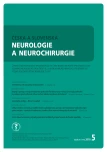Early complication after treatment of dissecting intracranial aneurysm in vertebrobasilar circulation with a flow-diverter
Authors:
L. Smetanová 1; D. Krajíčková 2; A. Krajina 3
Authors‘ workplace:
Rehabilitační klinika FN Hradec Králové
1; Neurologická klinika LF UK a FN, KCC, Hradec Králové
2; Radiologická klinika LF UK a FN, KCC, Hradec Králové
3
Published in:
Cesk Slov Neurol N 2018; 81(5): 599-601
Category:
Letter to Editor
doi:
https://doi.org/10.14735/amcsnn2018599
Overview
The authors declare they have no potential conflicts of interest concerning drugs, products, or services used in the study. The Editorial Board declares that the manuscript met the ICMJE “uniform requirements” for biomedical papers.
Sources
1. Briganti F, Leone G, Marseglia M et al. Endovascular treatment of cerebral aneurysms using flow-diverter devices: a systematic review. Neuroradiol J 2015; 28(4): 365 – 375. doi: 10.1177/ 1971400915602803.
2. Jiang B, Paff M, Colby GP et al. Cerebral aneurysm treatment: modern neurovascular techniques. Stroke Vasc Neurol 2016; 1(3): 93 – 100. doi: 10.1136/ svn-2016-000027.
3. Kocer N, Islak C, Kizilkilic O et al. Giant intracranial aneurysm: a case-based atlas of imaging and treatment. Istanbul: Springer 2016.
4. Patzig M, Forbrig R, Ertl L et al. Intracranial aneurysms treated by flow-diverting stents: long-term follow-up with contrast-enhanced magnetic resonance angiography. Cardiovasc Intervent Radiol 2017; 40(11): 1713 – 1722. doi: 10.1007/ s00270-017-1732-z.
5. Wang CB, Shi WW, Zhang GX et al. Flow diverter treatment of posterior circulation aneurysms. A meta-analysis. Neuroradiology 2016; 58(4): 391 – 400. doi: 10.1007/ s00234-016-1649-2.
6. Prabhakaran S, Wells KR, Lee VH et al. Prevalence and risk factors for aspirin and clopidogrel resistance in cerebrovascular stenting. AJNR Am J Neuroradiol 2008; 29(2): 281 – 285. doi: 10.3174/ ajnr.A0818.
7. Briganti F, Leone G, Cirillo L et al. Postprocedural, midterm, and long-term results of cerebral aneurysms treated with flow-diverter devices: 7-year experience at a single center. Neurosurg Focus 2017; 42(6): E3. doi: 10.3171/ 2017.3.FOCUS1732.
8. Lv X, Yang H, Liu P et al. Flow-diverter devices in the treatment of intracranial aneurysms: a meta-analysis and systematic review. Neuroradiol J 2016; 29(1): 66 – 71. doi: 10.1177/ 1971400915621321.
9. Šustrová Z, Černík D, Beneš J et al. Oboustranná ischemie paramediálního thalamu a Percheronova arterie. Ces Radiol 2018; 72(2): 90 – 95.
10. Percheron G. The anatomy of the arterial supply of the human thalamus and its use for the interpretation of the thalamic vascular pathology. Z Neurol 1973; 205(1): 1 – 13.
Labels
Paediatric neurology Neurosurgery NeurologyArticle was published in
Czech and Slovak Neurology and Neurosurgery

2018 Issue 5
- Memantine Eases Daily Life for Patients and Caregivers
- Hope Awakens with Early Diagnosis of Parkinson's Disease Based on Skin Odor
- Metamizole vs. Tramadol in Postoperative Analgesia
- Metamizole at a Glance and in Practice – Effective Non-Opioid Analgesic for All Ages
- Metamizole in the Treatment of Acute Postoperative Pain
Most read in this issue
- New insights in the diagnosis and treatment of amyotrophic lateral sclerosis
- Review of diseases with restricted diffusion on magnetic resonance imaging of the brain
- Cervical vertigo – fiction or reality?
- Anaesthesia and neuromuscular disorders
